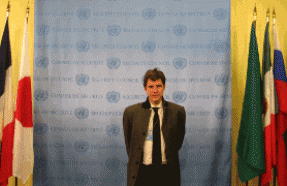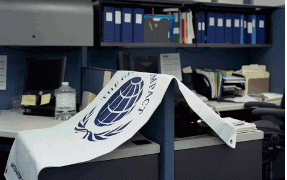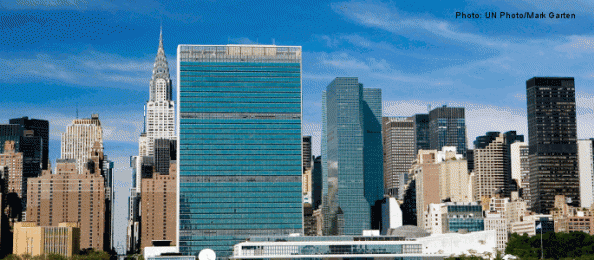Visiting the Global Compact Office
When I went to New York in March 2009, it was during the peak of the banking crisis and the self-doubts of the investment sector. There was a prevailing certainty that one economic era had come to an end, but ambiguity as to how the new era would look. Some of these elements are being intensively discussed and developed at the Global Compact Office: It is about lasting nature, transparency, responsible merchants, and the respectful handling of our planet.
The ejection from paradise finally took place at Sotheby’s. “The Peaceable Kingdom”, a naive depiction of conditions in paradise by Edward Hicks, was recently auctioned off there for just under 10 million dollars. The once superrich patron Ralph Esmerian had previously removed the painting from a New York museum. At present, this is not a unique event: Artwork on loan and promised gifts have been brought to the auction house a lot lately.
The crisis has a firm hold on New York: Stocks have fallen to unexpected lows, fancy restaurants wait in vain for customers, and boutiques are unabashedly announcing discounts of up to 50 percent, even on noble shopping miles like Fifth and Madison Avenues. The government, meanwhile, is simulating “stress tests” for its sick banks, and the weather is also acting crazy: Though already the beginning of March, it’s colder than it has been in decades. Even the airports had to shut down temporarily. Good thing, some announcers said, that nobody’s flying anyway because of the crisis.
In the UN district on the Hudson River, activity seems to be going on unabated. Delegations and visitors from around the world are pushing their way into the world-famous glass building to take part in a conference, one or the other of which is going on here almost all the time. Across the street is the Millennium Hotel, a popular accommodation for guests and speakers. Right next to it, almost inconspicuous, is the entrance area to one of the United Nations’ administration buildings. There on the sixth floor is DC2-612: the Global Compact Office.

Here, up to 25 people work in a space of barely 200 square metres on the vision of a just globalization. The floor is shared with the “UN Mine Action Service”, which has also provided the pictures in the shared hallway. The photos of mine victims in Afghanistan shake viewers up and remind them of the challenges the world faces. The working conditions in DC2-612 are cramped. Besides the work stations, the open-space office serves as a storeroom and a place to plan global strategy. “Still,” Global Compact spokesman Matthias Stausberg says with a grin, “each room has its own window and so has daylight.” That’s not always the case for US offices.
This is where the world’s largest and most important initiative for business responsibility has its headquarters. Unspectacular. Modest. That fits an initiative that, though sponsored by no less than the UN Secretary-General, does not draw attention to itself by making loud demands, but rather discreet recommendations. Founded 10 years ago, the UN Global Compact is a strategic policy initiative for businesses that are committed to aligning their operations and strategies with ten universally accepted principles in the areas of human rights, labour, environment and anti-corruption. Today, the Initiative includes well over 5,100 companies and other stakeholders from 130 countries around the globe.
The Global Compact sees itself as a dialogue forum that has promotion of its own ten principles on the agenda as well as support of broader UN initiatives, such as the Millennium Development Goals (MDGs). Critics counter that the Global Compact is a conglomeration of do-gooders. Toothless and weak. NGOs like Greenpeace or Oxfam consider every form of corporate social responsibility (CSR), and so also the Global Compact, to be pure window-dressing. For them, free trade only works with hard rules, not recommendations. But Global Compact director Georg Kell waves this aside: “No government bureaucracy can ever spread technology and innovation on the same scale and at the same speed as the private sector.”
Former UN Secretary-General Kofi Annan understood this. In 1997, he assigned Kell the task of sounding out the potential for cooperation between the UN and business. The man from southern Germany had previously gained experience with business cooperations as a development expert in Africa and Latin America. Two years later, he had to write a “really good speech” for Annan, Kell remembers during the interview. The UN Secretary-General wanted to hold the speech at the World Economic Forum in Davos as a direction-setting signal for the change of millennium. Kell was so nervous, he admits today, that he hardly heard a word. But the reactions were all the more clear: The vague vision of a Global Compact was so well received around the world that, within a decade, it would grow into the world’s leading umbrella brand for CSR. There’s a reason for its success: With the UN, the CSR issue has a credible sponsor. Companies, politicians, labour unions, scholars and civil-society groups feel equally represented and accepted here. The UN is one of the few supranational organizations whose credibility is widely recognized.
The Global Compact lives from this credibility and from members’ desire to work with each other, not against each other. Olajobi Makinwa today is issue manager for the subject of anti-corruption. Previously, the lawyer was director of Amnesty International in South Africa. In the interview, she remembers that, for her, business used to be the enemy. In contrast, respect and acceptance of the other side characterises the Global Compact. Tolerance as a unique selling proposition. But there were doubts not only from the NGO side; even in the UN itself, many shared this fear, adds Melissa Powell, Head of Strategy and Partnerships. At first there was even a caricature showing the UN Building with company standards and their logos replacing the national flags. Subtitle: “UN for sale”. Today, Powell receives weekly calls from the Building asking for help. “Many believe”, Powell says, “that the Compact is sitting on mountains of company cash that we can distribute as we see fit.” That, of course, is not true, she adds.
But for all participants, more important than the financing question is the upholding of credibility: Over the years, Kell and his team have quietly toughened the conditions of participation. The main instrument is the annually required Communication on Progress (COP). The COP must substantially report on the company’s engagement. Those companies that don’t submit it are first warned, then placed on the inactive list, and finally removed from the rolls. Even voluntary initiatives can have tough rules. In any case, the policy has consequences: Well over 600 companies have been delisted over the last few years. Is the Global Compact losing members then? On the contrary. The Initiative is constantly gaining in popularity, especially in the Southern Hemisphere. That is important, since it’s especially critical there to uphold labour, environmental and social standards. The ten principles must be implemented there in order to become a truly global standard.

The new UN Secretary-General Ban Ki-moon also stands behind the pact. This support is important, and the Secretary-General makes it clear that the Initiative can show us ways out of the crisis. Ban: “Ensure that your boards, subsidiaries and supply chain partners use the Compact as both a management guide and a moral compass.” Morality as a compass in these times? That sounds pious. But Kell becomes feisty: Especially now, we see that responsibility and long-term strategies pay off in the end.
That the worldwide crisis has come to a head in the finance and trade centre New York is understandable. And at the same time, it’s symbolic: New York, like almost no other city, incorporates globalization with all its achievements and excesses. The city is a melting pot of cultures, nationalities, lifestyles. New York is the city where every good, every service and every type of information is available at any time. But it’s also the city where one hour of parking costs as much as a pair of jeans sewn together in Bangladesh or Turkey. And where a simple dinner is as expensive as one year of school fees in Namibia. Everything in this city has its price, but only few ask about the value, Kell adds pensively. In this point, too, New York has followed its own path. The wrong path, Kell emphasises untiringly.
Regardless, nowhere did the price and profit spiral turn as consistently as on Wall Street and in the Financial District. At the same time, nowhere were so few questions asked about the value of the products as right here at AIG, Lehman Brothers, Bear Stearns, Citibank and the others. Every news broadcast and every discussion in the city’s innumerable delis now seems to revolve around the cause of the crisis: The answer has five letters – greed. Greed destroyed understanding. Greed made people careless about risk. Greed made people irresponsible. That has become clearer to everyone today than in the past. Even to those who, until recently, joked about the term “business ethics”.
Further down on the southern tip of Manhattan lies the heart of globalization and greed. From the Fulton Street subway station, it takes just a few minutes to walk to Wall Street: Here you can see the stockbrokers, the masters of the universe, as Tom Wolfe aptly called them in his novel. Men whose actions were guided solely by bonuses and commissions. Now the brokers inconspicuously pull on their jackets when they go out on the street. Not just because of the cold, as can be seen from their furtive glances to the left and right. Nobody wants to be recognised as a stock market speculator nowadays. The masters of the universe have grown meek. Many a finance and business magnate has taken on the role of enlightened sinner. The most spectacular was the confession of Jack Welch: The long-time CEO of General Electric and icon of US industry declared this spring that striving for short-term profits and higher share prices is a “dumb idea”. “On the face of it, shareholder value is the dumbest idea in the world,” Welch told the Financial Times. “Shareholder value is a result, not a strategy … Your main constituencies are your employees, your customers and your products.”
Still, at Global Compact no one is happy about the crisis. Too obvious are the social and ecological costs that now have to be paid throughout the world: In China alone, 25 million migrant workers have been hit by mass layoffs so far. In Africa, the crisis is destroying the already meagre buds of economic growth. Australia, for its part, has largely put its climate protection promises on ice: Introduction of emissions trading has been postponed with the curt justification that the economic situation doesn’t permit it. And so the next step of the crisis is now starting: When companies get into trouble, the state currently jumps in. But who will stand by the state when it gets into trouble, as is happening in Iceland and many eastern European countries? Not long ago, British Prime Minister Gordon Brown warned of “deglobalization”, an implosion of world trade with fatal results for social systems and political orders.

Freedom without boundaries must fail, German Interior Minister Schaeuble warns. But freedom itself must not be put up for grabs in consequence. Rather, crash barriers need to be erected. And to continue with the thought process, there must also be guiding stars. Both, crash barriers and guiding stars, mark a new economic order, to which the Global Compact can give answers. Kell: “The quarterly short-term thinking that prevailed for so long is slowly giving way to a more comprehensive, sustainable risk assessment.”
Olajobi Makinwa also sees opportunities for new moral guidelines: “It made people start asking questions,” she says with hope. Fundamental strategies are being tested. She herself is responsible for the issue of corruption and notes that many companies are now asking her for advice, since ethics are becoming more widely understood as providing a direction for the future.
Only the spokesman Matthias Stausberg is not as optimistic as some of his colleagues. He currently sees two contradictory tendencies: On the one hand, there are a growing number of companies that, in panic and fully without reflection, are axing all budgets that aren’t essential for daily business. All strategic orientation has clearly been jettisoned, and long-term thinking has given way to the struggle for short-term survival. On the other hand, of course, there are companies that understand how to adapt to the situation. The core question for Stausberg is, what is the appropriate stimulus to cause a change from short-term to long-term thinking? A corresponding insight in management circles, as is currently being called for, is certainly essential. But also just as important is a state that creates incentive systems, consumers that reward such companies through conscious consumption decisions and investors that look for more than supposedly dream yields.
The Green New Deal, which is being talked about so much these days, is an idea many people have to get used to. Still: “It’s time for a change” seems to be the phrase of the hour, thanks to President Obama. New York is perhaps an indicator for this change as well. The city wants to become greener. On the one hand, it wants to animate more and more people to switch to buses and subways, and on the other, it wants to make buildings, such as the currently highest skyscraper in the city – the Empire State Building – into model projects for energy efficiency. “With the renovation of the Empire State, we want to emphasise that 80 percent of the greenhouse gas emissions in New York are caused by buildings,” New York Mayor Michael Bloomberg says. The Empire State Building project can save 38 percent of the energy used. To achieve this goal, 6,500 conventional windowpanes on the building’s surface will be replaced by thermopane glass. In addition, the building’s heating and air conditioning and electrical systems will be made state of the art. Experts estimate the savings at 4.4 million dollars per year, which will save 105,000 tons of CO2 in 15 years. Even now, the 78-year-old building glows green in the evening to show its good will.
But let’s not get caught up in too much euphoria. The outcome of the painting auction at Sotheby’s should be a warning. The successful bidder has since fallen into financial trouble and is trying to back out of the purchase. A lawsuit has been filed between him and Sotheby’s. One thing, at least: Until the dispute is settled, the picture will remain in the museum.
Dr. Elmer Lenzen is founder and CEO of the macondo publishing GmbH, publisher of the Global Compact International Yearbook and the CSR Academy. He has a PhD in Journalism and studied at the Universities of Münster, Bochum (both Germany) and the UCR in San José (Costa Rica). In 1998 Elmer founded macondo with major business areas in publications and corporate communication. CSR plays a prominent role and macondo today is one of the leading publishing houses.
About Us // Privacy Policy // Copyright Information // Legal Disclaimer // Contact
Copyright © 2012-2018 macondo publishing GmbH. All rights reserved.
The CSR Academy is an independent learning platform of the macondo publishing group.









